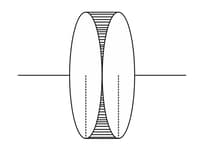Two Thin Lenses in Contact
Two Thin Lenses in Contact: Overview
This topic covers concepts such as Thin Lenses in Contact, Effective Focal Length for Lenses in Contact, Effective Power for Lenses in Contact, and Focal Length of Lenses at Some Separation.
Important Questions on Two Thin Lenses in Contact
An eye specialist prescribes spectacles having a combination of convex lens of focal length 40 cm in contact with a concave lens of focal length 25 cm. The power of this lens combination in diopters is
Derive an expression for the effective (equivalent) focal length of two thin lenses in contact.
The powers of two lenses in contact are and . What is the equivalent power?
A convergent doublet of separated lenses, corrected for spherical aberration, has resultant focal length of 10cm. The separation between the two lenses is 2cm. The focal lengths of the component lenses
If two lenses of focal lengths are kept in contact with each other, what will be the effective power(in dioptres) of the combination?
If two lenses of focal lengths are kept in contact with each other, what will be the effective focal length(in centimetres) of the combination?
If two lenses of focal lengths are kept in contact with each other, what will be the effective focal length of the combination?
Derive the equation for the effective focal length of lenses in contact.
Two plano-concave lenses of a glass of have radii of curvatures and . They are placed in contact with curved surfaces towards each other and space between them is filled with liquid of , the focal length of the system is
The dispersive powers of the materials of the two lenses are in the ratio If the achromatic combination of these two lenses in contact is a convex lens of focal length then the focal lengths of the component lenses are
Magnification by a lens of an object at distance 10 cm from it is -2. Now a second lens is placed exactly at the same position where first was kept, without changing the distance between object and lens. The magnification by this second lens is -3.
What is the focal length of the combination when both lenses are in contact?
Magnification by a lens of an object at distance 10 cm from it is -2. Now a second lens is placed exactly at the same position where first was kept, without changing the distance between object and lens. The magnification by this second lens is -3.
Now both the lenses are kept in contact at the same place. What will be the new magnification?
Two thin lenses are of same focal length but one is convex and the other one is concave. When they are placed in contact with each other the equivalent focal length of the comobination will be
An eye specialist prescribes spectacles having a combination of a convex lens of focal length in contact with a concave lens of focal length . The power of this lens combination is
Two lenses of focal length and are held in contact. The image of an object at infinity will be formed by the combination at
A plano concave lens of radius of curvature and refractive index has focal length Similarly a
plano convex lens of radius of curvature and refractive index has focal length Both lenses are
joined so that there is no gap between them. Find equivalent focal length of combined system.
Two identical equiconvex lenses, each of focal length are placed side by side in contact with each other with a layer of water in between them as shown in the figure. If refractive index of the material of the lenses is greater than that of water, how the combined focal length is related to ?

Three thin lenses are combined by placing them in contact with each other to get more magnification in an optical instrument. Each lens has a focal length of 3 cm. If the least distance of distinct vision is taken as 25 cm, the total magnification of the lens - combination in normal adjustment is
A simple microscope consists of a concave lens of power - 10 D and a convex lens of power + 20 D in contact. If the image formed at infinity, then calculate the magnifying power (D = 25 cm)
An eye specialist prescribes spectacles having combination of convex lens of focal length in contact with a concave lens of focal length . The power of this lens combination in diopters is
